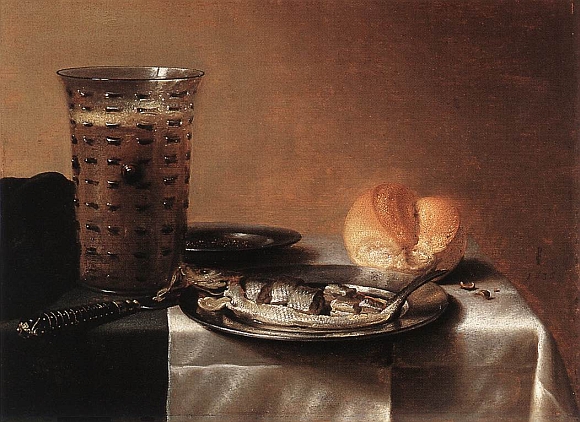
Effets de la gourmandise sur la sociabilité. La gourmandise est un des principaux liens de la société; c’est elle qui étend graduellement cet esprit de convivialité qui reunite chaque jour les divers états, les fond en un seul tout, anime la conversation, et adoucit les angles de l’inégalité conventionnelle. C’est elle aussi qui motive les efforts que doit faire tout amphitryon pour bien recevoir ses convives, ainsi que la reconnaissance de ceux-ci, quand ils voient qu’on s’est savamment occupé d’eux; et c’est ici le lieu de honnir à jamais ces mangeurs stupides qui avalent avec une indifférence coupable les morceaux les plus distingués, ou qui aspirant avec une distraction sacrilège un nectar odorant et limpide.
The Consequences of Gourmandise for Sociability. Gourmandise is one of the principle social ties. It gradually extends that spirit of conviviality, which every day unites different strands of society, mingles them together, and diminishes the angles of conventional inequality. This it is, which induces every amphitryon to receive his guests well, and also excites the gratitude of the latter when they see themselves well taken care of: here is the place to reprobate those stupid masticators, who with the most guilty indifference to the greatest luxuries, and who with sacrilegious indifference inhale the odorous perfume of nectar.
—Jean Anthelme Brillat-Savarin, Physiologie du goût, ou, Méditations de gastronomie transcendante. Ouvrage théorique, historique et à l’ordre du jour, méditation xi, sec 59 (1848)(S.H. transl.)
Brillat-Savarin, a brilliant commercial lawyer, made his mark on the world with the development of the concept of gourmandise. Humankind distinguishes itself from the other creatures of the earth, he writes, in that it turns to food not simply for nourishment, but also as a form of art. Just as we value the sense of sight, and that of smell, so we should also value that of taste, and note of course that true gourmandise engages the other senses as well. Brillat-Savarin rejects utterly the idea that gourmandise is something for the wealthy and the elite. On this point he’s in the corner of Alice Waters and the slow food movement: he favors honest, simple ingredients, patience and experimentation. And he also values the cook, who combines artistry with a firm grasp of chemistry and physics. A great meal doesn’t turn on access to things rare and exotic, but rather on ingenuity in using the fresh produce you find about you. His Physiologie du goût can of course be read as the musings of a dandy, as something completely trivial–unless of course, you care about food. Then you’re likely to recognize the flashes of brilliance that run through the entire work. Having read it, you’ll never think of cheese the same way again.
It’s also fascinating as a historical chronicle of Brillat-Savarin’s times. He served as a deputy during the era of the revolution, and his conservative sentiments quickly got him on the list of those to be apprehended during the Terror. He fled to Switzerland, and then across the sea to the United States. Once there, he took immediately to sampling the culinary and tavern life of the young democracy, and especially of New York–much of which is chronicled meticulously in the Physiologie du goût. (New York cider gets a decided thumbs-up, by the way, the Long Island oysters were also a major draw and his recounting of a repast worthy of Lucullus consumed at a tavern a short jaunt from Wall Street is one of the book’s high points). As the reading makes clear, for Brillat-Savarin, the meal is an essentially social activity, an opportunity to reach across the lines of class and society and to enjoy the bounty of nature and the company of fellow men and women.
The year in which Brillat-Savarin’s work was published, Alexandre Dumas fils published the work that would prove the greatest operatic inspiration in literature, La Dame aux camélias. Five years later, Giuseppe Verdi completed its first realization for the opera, La Traviata. And “Brindisi,” which may be its best known offering, is a perfect match for Brillat-Savarin–plenty of champagne, though the oysters are missing. In this recording Richard Tucker and Anna Moffo sing:
To follow the oysters and champagne, here’s Brillat-Savarin’s leg of lamb for the springtime table:
Butterfly a leg of lamb and coat it with a paste made of the following:
½ cup Dijon-style mustard
2 Tb soy sauce
2 cloves of garlic, mashed or riced
3 oz of freshly grated ginger
the leaves of a sprig of thyme, chopped finely
2 Tb olive oil
Blend all the ingredients save the olive oil in a bowl, then add the olive oil drop by drop, whipping it steadily, to form an emulsified paste with the consistency of mayonnaise. Two excellent variants to this–chop the garlic with the leaves of a fresh sprig of rosemary, or add the juice of a lemon (especially if you prefer your lamb a bit less sweet).
Pierce the lamb with the point of a sharp knife about twenty times. Then spread the mustard mixture all across the top side. Best to do this at least four hours before cooking the lamb (overnight is better still), leaving the mixture to marinade the lamb.
Roast the lamb in a 350° F oven until done (or even better, grill it and it will develop a magnificent crust). It will take over an hour, depending on how you like your lamb, or less if grilled. (Medium rare is best for this dish). Let it rest for ten minutes, carve, and cover liberally with freshly ground black paper.
Serve the lamb with young roasted potatoes, and spring vegetables such as baby carrots and asparagus. It goes well with a good Napa cabernet or a Bordeaux. Follow with a green salad, and then a plate of cheese with fresh fruit and a good crusty bread. What cheese? Brillat-Savarin, of course.



